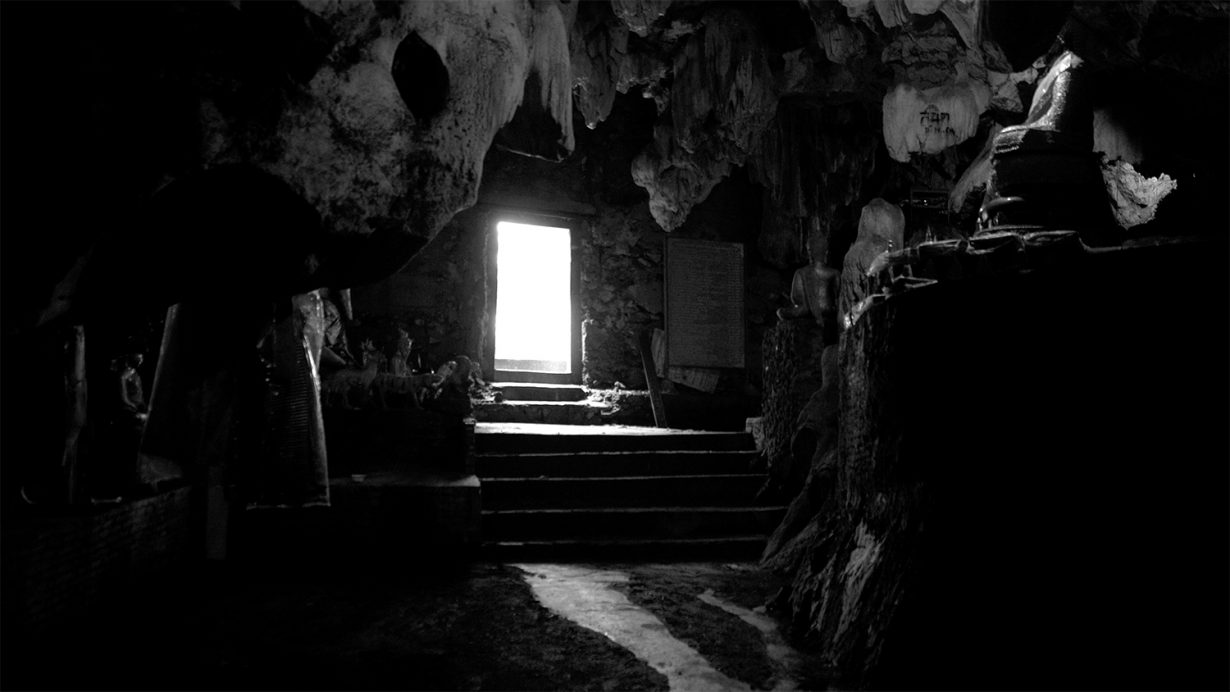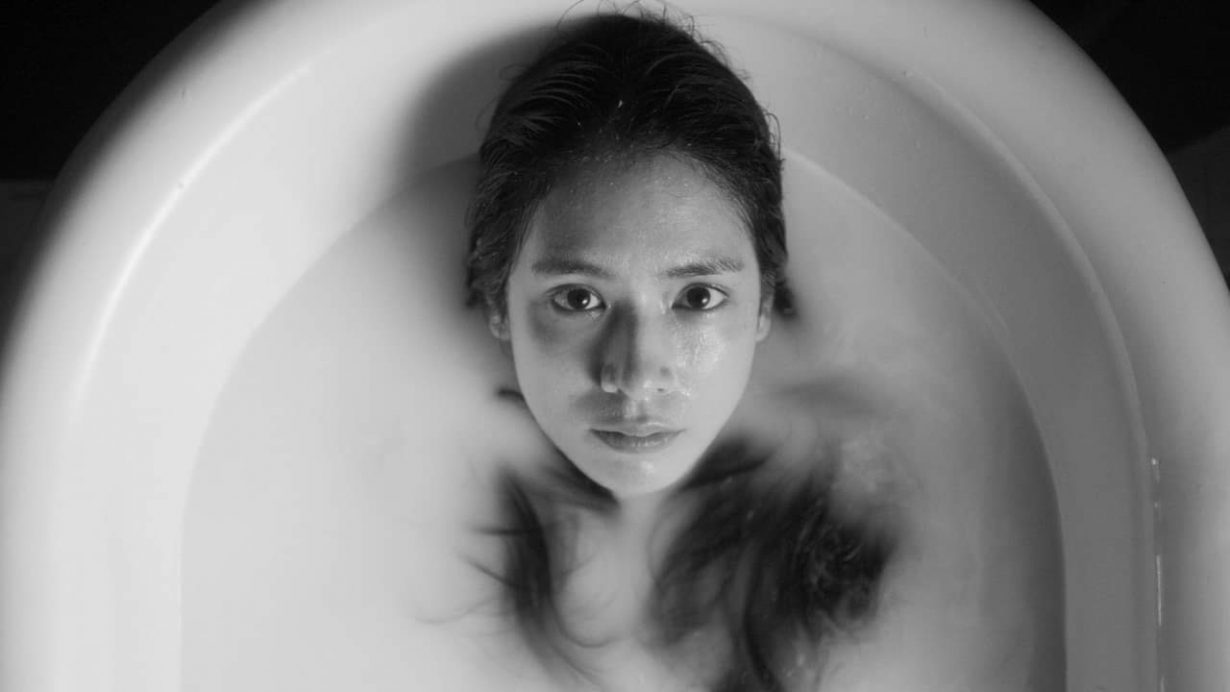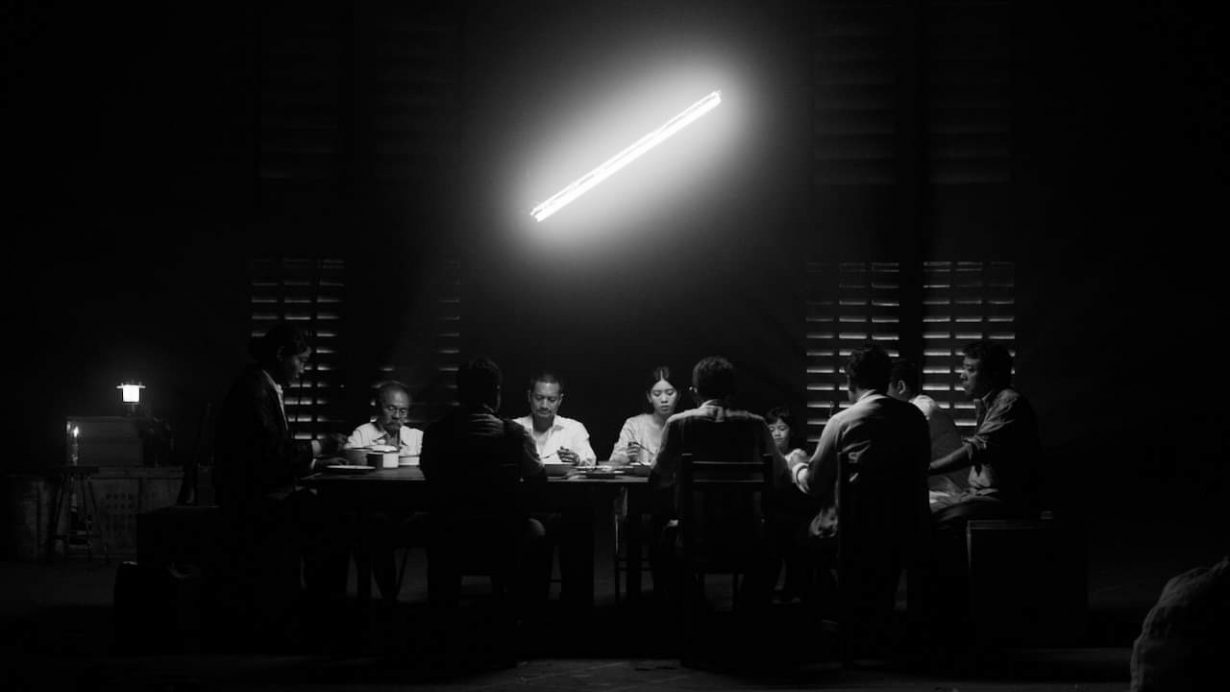The filmmaker uncovers the cyclical nature of Thailand’s troubled past
About two-thirds of the way into Bangkok-based Taiki Sakpisit’s new black-and-white video installation, the mood shifts erratically – from bucolic calm to blissed-out to rage. Held for about a minute and a half is a static shot of a tiered waterfall. It is followed by an even more serene vision: a distant sphere of sunlight flickering on a shifting horizontal plane, the light dancing up and down to a whining note. Then we cut to raw, handheld footage from the student-led Bangkok street-protests of 2020. The camera’s eye is distorted, drunk almost, but you can just about make out riot police, the crowd in hard hats and other makeshift protective gear, a young woman wearing a water- proof poncho pushing through it. Then suddenly, out of nowhere, a glitch metastasises: images from the water-cannon-drenched frontline of this progressive protest movement quickly devolve into a seething cataclysm of throbbing pixels and screaming noise.
Such juxtapositions – and the lack of guidance towards their easy interpretation – are a common feature of Sakpisit’s sui generis body of experimental films stretching back to 2008. Another is an audiovisual armoury consisting of bold cuts, extreme closeups, slow dissolves, ambient noise and musique concrète. Sometimes his meticulous assemblages are searchingly personal: ornate and oneiric memory palaces built out with mental fragments and emotional debris that belong to him alone. Other works channel or index the presence of places upon which the inexorable movement of Thai history has left an indelible stain. But whatever their apparent subject, the emotional response created by Sakpisit’s dynamic and often discombobulating interplays of sound and image is paramount, gesturing towards states of anguish, paralysis or insanity, be it individual or collective.

For most of its 29-minute running time, Seeing in the Dark (2021) centres on Khao Kho, a famous mountain range in Thailand’s Phetchabun province where paranoid governments and communist insurgents sought refuge at separate points during the mid-to-late twentieth century. It opens with panoramic views from Khao Kho Sacrifice Memorial, an open-air mountainside museum where the shredded carcasses of felled helicopters sit alongside rusting artillery, shell casings and dead-eyed mannequins in military garb. The camera lingers on topographic models and matériel, the images cutting or dissolving to a nagging drone sound. After focusing on the tired military legacy of the Kingdom’s protracted war against Khao Kho’s communist strongholds, attention then shifts to the overgrown cave fortress that was, for a brief spell, its official treasury. Here, at the bidding of dictatorial Prime Minister Field Marshal Plaek Phibunsongkhram, one of the leaders of (what was then called) Siam’s 1932 revolution against absolute monarchy, the country’s gold bars and sacred Emerald Buddha were hidden from the Japanese during the Second World War. Something of the weight of these layers of human history, as well as nature’s indifference, is conveyed through the long take and the oceanic expanse of roiling found sound accompanying it. Flies buzz conspiratorially. A closeup of a rock face dissolves to reveal a trickling stream, then a lean-to in which communist rebels lived and, likely, died. As the bellowing sonic textures swirl and rise to a disconcerting crescendo, one gets a sense of the aftermath of past battles, but also of looming presences, new fights.

While never polemical or pedagogic, trafficking in fey allusions and sensorial insinuations rather than agitprop, Sakpisit’s works often betray a resounding political commitment, particularly when it comes to obliquely (re)connecting spectators with the traumas of Thailand’s Cold War and the autocratic oppression of the 1970s, 1990s and 2000s.
In Shadow and Act (2018) he navigates the desiccated remains of Chaya Jitrakorn, a defunct Bangkok photo studio, built in 1940, that Phibunsongkhram apparently frequented. To an equally ominous organic-industrial soundscape, Sakpisit’s drifting gaze homes in on small details: retired equipment; old whiteboards; passport portraits of remote society families and figures, among them the faces of two other dictators, Sarit Thanarat and Thanom Kittikachorn. A few minutes in, the whirring blades of a ceiling fan lend a scurrying, pitter-patter tempo to a white-noise feedback-loop set to gliding closeups. And suddenly we are somewhere else. Somewhere no less grounded in artifice, it would seem: the reptile house at the Thai capital’s Dusit Zoo. To the syncopated rhythms of Indonesian drumming, Sakpisit closes out this 23-minute work with slow-motion footage of green anacondas, lizards and other nocturnal creatures slithering and stirring in the wan light of their dioramalike enclosures.

Even to Thai spectators, Shadow and Act’s dislocation between a Thai photostudio and zoo might seem arbitrary. Yet its juxtaposition of images filmed at disparate locales is not without rhyme or reason. After the Siamese revolution of 1932 put an end to almost 800 years of absolute rule, it was Phibunsongkhram who petitioned King Rama VIII to open up a private park reserved for the royal family to the public. In 1938 that new municipal park officially became Dusit Zoo: a popular leisure retreat for plebeian Bangkokians. Of the genesis of the piece, Sakpisit explains: “Originally I was interested in the cult of personality surrounding dictators. Their acts and gestures. How they dress and pose. And the nocturnal zoo is, in a way, a theatre. The primal force of the animals here relates to the first part: the dictators.” Since Shadow and Act’s completion, the furtive (some would say reptilian) plotting at the heart of Thailand’s military-royalist theatre has thickened, adding to the work’s sociopolitical resonances. In late 2018 the nation’s oldest zoo was closed on orders of the current monarch, the request dovetailing with a broader, systematic campaign to efface the legacy of Phibunsongkhram’s 1932 coup d’état (and, by extension, the transition to a constitutional monarchy it hastened).

By turns elegiac and unnerving, Sakpisit’s films may hinge upon such details, but their appeal is rarely contingent upon our knowledge of them. A skilled editor, he typically shoots alone using a compact, mirrorless camera, and always with the emotions he hopes to provoke or mediate through his final cut in mind. “It’s really necessary for me to be in each space alone and to absorb the energy of those landscapes and then think and try to detect tiny things and find inspiration. For me, it’s like solving a puzzle,” he explains. “Do I have enough? Will it work? It’s a dialogue with myself.”
Edited using a formalist approach that favours technical aspects – particularly the sound-image tension and the rhythmic possibilities of montage – over and above any guiding sense of narrative, the resulting images are often as evocative as they are everyday, drawing our attention to the splendour of the ordinary.

In A Ripe Volcano (2011) and Three Kings (2011), both filmed around sites in Bangkok’s old city, Rattanakosin, during the political protests of 2010, the movements of male bodies – young boys, policeman, glistening boxers, cheering spectators – are slowed to an ominous crawl, their every glance or gesticulation charged with meaning. In the Singapore-set A Certain Illness Difficult to Name (2018), Sakpisit pans and pauses over the landscape of a city-state in transition: rotting mushrooms, folk killing time on a swaying ferry, a kettle of birds wheeling high above. And in To the Memory of My Beloved (2018), his tender medi- tation on remembrance set to soaring cello and industrial rhythms, images of worshippers at an Ash Wednesday ceremony are suffused with heartache.

These and other films are disarmingly sensuous as well as deftly allegorical. Even without context, his uncanny vignettes of quotidian detail – particularly the intensified movements of men and animals – and synesthetic treatment of time – as a spatial construct that is viscous and volatile, if never quite fully solid – is transporting. Recent films such as Trouble in Paradise (2019), a woozy tableau vivant combining images of racing orbs of light, restless water buffaloes and a Buddhist sai sin (white string blessing) ceremony, appear fully grounded in Jean-Luc Godard’s observation that the ‘supreme ambition’ of montage is ‘to make the heart prevail over the intelligence by destroying the notion of space in favour of that of time’.

Often praised by his fellow Thai filmmakers, Sakpisit is now looking beyond video art: early 2021 saw him release his first feature film to wide festival-circuit acclaim. Like its precursors, The Edge of Daybreak (2021) is both sensual and fragmented, but it draws on a more baroque palette, not least an expressionistic mise-en-scène filmed in silvery, high-contrast monochrome. It is also, on the face of it at least, a taciturn pyschodrama. Whereas many of his short films index trauma through an immersive and intentionally uneasy experimental formalism, The Edge of Daybreak is a tense psychological study cloaked in a claustrophobic, gothic-noir atmosphere of impending dread. The mood – or rather the burden of unnamed and unseen events – slowly suffocates its somnambulant characters: a family made up of women who sleep or stagger, numb and inert, around a rambling house, and of sullen men who come and go.
Myriad collaborators and reference points were integral to its genesis. For his shorts, sound is the only element Sakpisit cedes a small measure of authorial control over, but for The Edge of Daybreak he enlisted professional actors, a cinematographer and an editor, as well as his most frequent collaborator, the Japanese musical director Yasuhiro Morinaga. The spare sound design, by Arkritchalerm Kalayanamit, is particularly effective: Morinaga’s organic soundscapes – which are directly inspired by the natural instrumentation and electro-acoustic timbres of Tōru Takemitsu’s soundtrack for The Woman in the Dunes, as well as the brutal cadences of the Taiko drum in Onibaba (both 1964), scored by Hikaru Hayashi – provide an eerie percussive foil to the film’s rococo symbology, crepuscular setting and quizzical exchanges (“What are you thinking about?”… “Rats in the attic”).

While writing his laconic script, Sakpisit immersed himself in the dramaturgy of poetic realism and the European avant-garde, particularly Jacques Prévert’s screenplay for Marcel Carne’s Port of Shadows (1938) and Andrzej Zulawski’s The Third Part of the Night (1971). Other films cited in recent interviews include Jacques Tourneur’s I Walked with a Zombie (1943), Stan Brakhage’s Window Water Baby Moving (1959) and Carl Theodor Dreyer’s Gertrud (1964). Instead of a storyboard, he and his crew relied on an exhaustive, 819-page moodboard that mapped out every scene, “even down to how the beds are folded”. Among the welter of hyperstylised imagery appearing out of the chiaroscuro gloom is a peeling slaughterhouse inspired by Canadian artist Jeff Wall’s photograph The Destroyed Room (1978). Another, a naked female body that serves as a recurring motif, draws on the hauntingly corporeal work of Belgian sculptor Berlinde De Bruyckere.

After working in relative isolation for over a decade, the experience was rewarding – especially as the film’s human textures are, he adds, deeply personal. “The characters, the nuances, the relationships: they are drawn from my own experiences,” he says. “The film is not necessarily a political film. In a way I wanted to make something more universal… and that I would enjoy the process of making.” This said, viewers familiar with Thai modern history can hardly fail to spot its stubborn pathological conditions: the disappearances, exiles, returns, the irresolution and the estrangement. The film’s bifurcation between politically important periods, the student uprisings of the mid-1970s and the simmering tensions and street battles of the 2000s, is also an open secret, signposted in the promotional synopsis.

The Edge of Daybreak is, as May Adadol Ingawanij wrote for this year’s International Film Festival Rotterdam (at which it won the critic’s FIPRESCI award),‘an unusual cinematic response to a question that has been growing in urgency among artists and filmmakers in Sakpisit’s homeland: What must art and cinema do to portray Thailand’s legacy of militarisation and impunity?’ Other Thai filmmakers, namely Anocha Suwichakornpong and Apichatpong Weerasethakul, have responded to that question in a similarly enigmatic way, namely by defying linearity, embracing the cryptic nature of elliptical narratives, experimenting with temporal fluidity, exploring the boundaries between the supernatural and natural, and so forth.
Sakpisit, however, is singular among the country’s more subversive filmmakers for his sustained and purposeful production of discomforting modes of heightened spectatorship. Through an expanding palette of technical and stylistic strategies, he makes concrete the cyclical nature of Thai political history and its effects on the national psyche. In The Edge of Daybreak, the characters are sleepwalkers captive within a coiling, visceral nightmare that even a solar eclipse and gathering storm cannot shake off. In his shorts, meanwhile, the predicament in which the Thai people find themselves – the powerless recipients of 13 successful coups (and many more coup attempts) since the start of the twentieth century, and almost as many autocratic governments – is inventively hypostatised, typically through the haunting montage or irrational cut.

Among the successful examples of the latter are two studies in repetition made during the early 2010s, amid the rancorous after- shock of an unelected government’s brutal suppression of the ‘Red Shirt’ protest movement: Time of the Last Persecution (2012) and The Age of Anxiety (2013). Both splice grainy footage sourced from a once-popular genre of 1980s Thai B-movie – fantasy epics such as Ka Kee (1980) and Krai Thong (1985) – into kinetic onslaughts of stuttering energy. The former, stripped of its audio track, draws its intensity from its severe juxtapositions: silently grimacing princes and princesses, crocodiles submerging, legendary Thai actor Sorapong Chatree kissing a folkloric goddess, fanged king of the demons Totsakan raining down bolts of fire. The latter is even more antagonising, images of bodies and faces appearing in strobelike flashes alongside the industrial squeals and guttural screams of Noise music.

‘The desire to change everything in the world so as to change one’s destiny was the source of emotional intensity of these obsolete films,’ wrote Ingawanij in 2013 for Cinémathèque Quarterly. In these ecstatic displays of brute force, Sakpisit registers and remembers the full magnitude and implications of this emotional intensity for Thais during that era. But like the government that sent the army in to clear protesters in 2010, or in the case of the similarly brutal street suppres- sions of 1973 and 1976, he also brutalises that intensity, repeats acts of violence against it, all while never quite stilling the anarchic energy and sovereign spirit at its core. This renewal and reconfiguration of latent promise and looming dangers, this urge to exploit the manifold possibilities of sound and image in order to circumscribe and evoke the recurring themes and trajectories of a nation’s scarred history, is common to large swathes of his output.
Take, for example, the glitching that corrupts Seeing in the Dark’s closing section. Here we experience the brutal response of a broken system, the paranoia and paralysis of a military-royalist nexus that endures and prospers by venerating some and vilifying others. Those that challenge their grip – be it the communist insurgents of Khao Kho, the ‘Red Shirts’ or the youth ‘mob’ – are an enemy to be dehumanised and crushed. In its dying seconds, Sakpisit’s latest short film follows the base and boring logic of this depressing trope of authoritarian power to its all-too-predictable conclusion: after the chaos and fury of the crisis or purge comes a return to the status quo. Back in the caves of Petchabhun, we find the Buddhist icons, the primal creatures, the mythic stories of brave battles that are no more than barely veiled propaganda still undisturbed amid the dripping stalactites. The youth-protest leader’s promises to fight on like ‘water eroding rocks’ have left no apparent trace. Sakpisit describes, in his own indescribable language, a peculiarly Thai kind of lull or respite: a peace that thrives on distorted echoes of the past and very long shadows.
Seeing in the Dark, SAC Gallery, Bangkok, 13-18 December
